新目标初一英语上册教案Unit 11 What time do you go to school.
- 格式:doc
- 大小:38.50 KB
- 文档页数:4
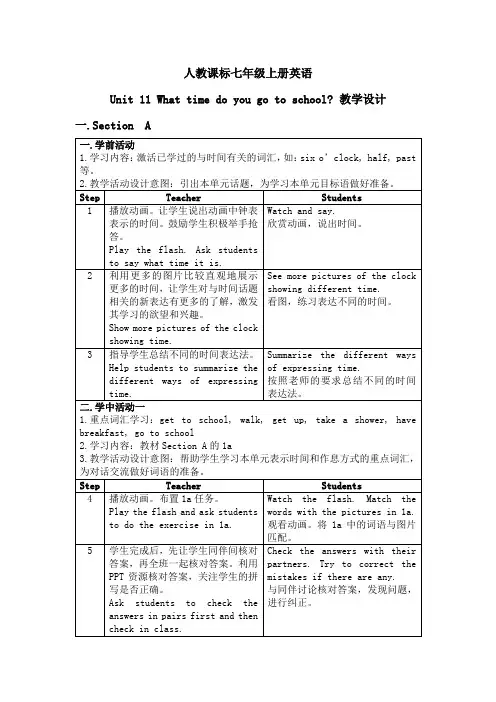
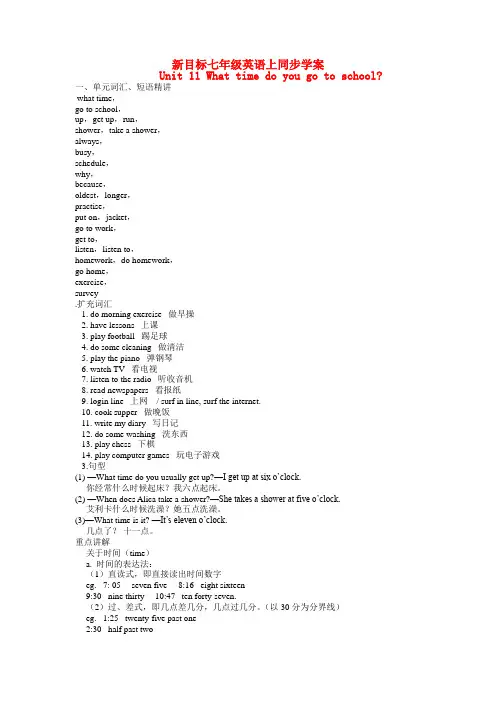
新目标七年级英语上同步学案Unit 11 What time do you go to school?一、单元词汇、短语精讲what time,go to school,up,get up,run,shower,take a shower,always,busy,schedule,why,because,oldest,longer,practise,put on,jacket,go to work,get to,listen,listen to,homework,do homework,go home,exercise,survey.扩充词汇1. do morning exercise 做早操2. have lessons 上课3. play football 踢足球4. do some cleaning 做清洁5. play the piano 弹钢琴6. watch TV 看电视7. listen to the radio 听收音机8. read newspapers 看报纸9. login line 上网/ surf in line, surf the internet.10. cook supper 做晚饭11. write my diary 写日记12. do some washing 洗东西13. play chess 下棋14. play computer games 玩电子游戏3.句型(1) —What time do you usually get up?—I get up at six o’clock.你经常什么时候起床?我六点起床。
(2) —When does Alica take a shower?—She takes a shower at five o’clock.艾利卡什么时候洗澡?她五点洗澡。
(3)—What time is it? —It’s eleven o’clock.几点了?十一点。

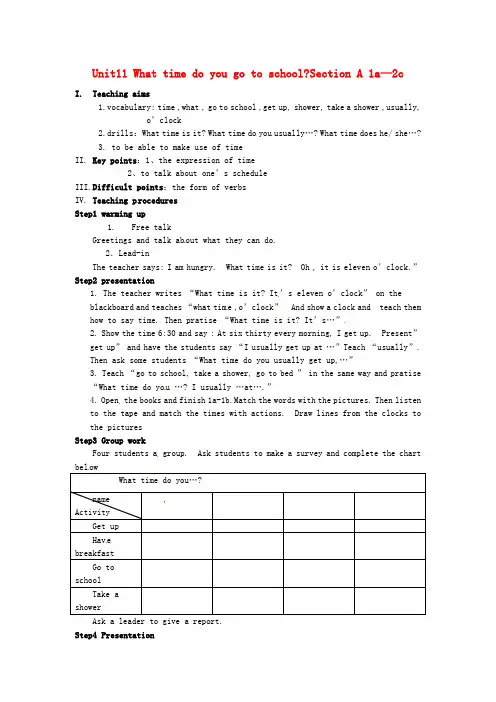
Unit11 What time do you go to school?Section A 1a—2cI.Teaching aims1.vocabulary: time ,what , go to school ,get up, shower, take a shower ,usually,o’clock2.drills:What time is it? What time do you usually…? What time does he/ she…?3. to be able to make use of timeII.Key points:1、the expression of time2、to talk about one’s scheduleIII.D ifficult points:the form of verbsIV.Teaching p roceduresStep1 warming up1. Free talkGreetings and talk ab out what they can do.2.Lead-inThe teacher says: I am hungry. What time is it? Oh , it is eleven o’clock.” Step2 presentation1. The teacher writes “What time is it? It’s eleven o’clock” on theblackboard and teaches “what tim e ,o’clock” And s how a clock and teach them how to say time. Then pratise “What time is it?It’s…”2. Show the time 6:30 and say : At six thirty every morning, I get up. Present”get up”and have the students say “I usually get up at …”Teach “usually”.Then ask some students “What time do you usually get up,…”3. Teach “go to school, take a shower, go to bed ”in the same way and pratise“What time do yo u …? I usually …at….”4. Open the books and finish 1a-1b.Match the words with the pictures. Then listento the tape and match the times with actions. Draw lines from the clocks to the picturesStep3 Group workFour students a group. Ask students to make a survey and complete the chart bel owWhat time do you…?nameActivityGet upHav ebreakfastGo toschoolTake ashowerAsk a leader to give a report.Step4 Presentation1.The teacher asks one student “What time do you get up?”The student answers “I usually get up at….Then ask other students :What time does he/she get up? Have the students answer :He/She gets up at….2. Present “What time does/ he/she get up?He/She gets up at …” Then the teacher asks :What time do you…? A student answers:I usually … at….Then ask other students :What time does he/she …? Have the students answer :He/She … at….(Pratise the sentence pattern using the words they have learnt.)Step5 Pratice1.Finish 2a-2bLet the students look at the picture on P66. And ask: How many children can you see? Ss: Five children and a shower. Lead in the shower schedule for Rick’s family.①Listen to the tape. Complete these sentences with words from the box..②Listen again. Complete the shower schedule for Rick’s family.③Read the conversation after the tape.2. Pair workAsk and answer the questions about the shower times in 2b.Using What time does … take a shower? She /he takes a shower at… Pay atte ntion to does & takes.Step6 Sum-up(1)Have the students say “What have they learnt ? How to errange time?(2)Homework① A student is the interviewer, the other is Rick. Ask and answer questions about Rick’s day.② Read the tape script by heart.V.Writing on the blackboardUnit11 What time do you go to school?What time is it? What time do you usually get up?It’s seven o’clock. I usually get up at six thirty.What time do es he/she get up?He/She get s up at six o’clock.7:00 seven o’clock6:30 six thirty8:10 eight ten。
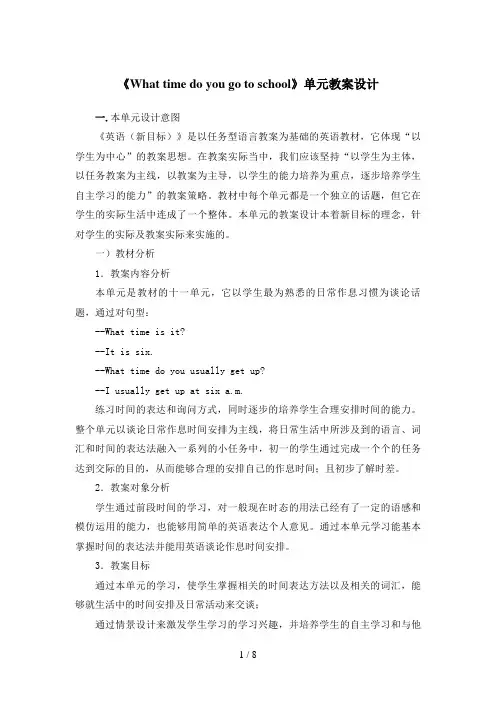
《What time do you go to school》单元教案设计一.本单元设计意图《英语(新目标)》是以任务型语言教案为基础的英语教材,它体现“以学生为中心”的教案思想。
在教案实际当中,我们应该坚持“以学生为主体,以任务教案为主线,以教案为主导,以学生的能力培养为重点,逐步培养学生自主学习的能力”的教案策略。
教材中每个单元都是一个独立的话题,但它在学生的实际生活中连成了一个整体。
本单元的教案设计本着新目标的理念,针对学生的实际及教案实际来实施的。
一)教材分析1.教案内容分析本单元是教材的十一单元,它以学生最为熟悉的日常作息习惯为谈论话题,通过对句型:--What time is it?--It is six.--What time do you usually get up?--I usually get up at six a.m.练习时间的表达和询问方式,同时逐步的培养学生合理安排时间的能力。
整个单元以谈论日常作息时间安排为主线,将日常生活中所涉及到的语言、词汇和时间的表达法融入一系列的小任务中,初一的学生通过完成一个个的任务达到交际的目的,从而能够合理的安排自己的作息时间;且初步了解时差。
2.教案对象分析学生通过前段时间的学习,对一般现在时态的用法已经有了一定的语感和模仿运用的能力,也能够用简单的英语表达个人意见。
通过本单元学习能基本掌握时间的表达法并能用英语谈论作息时间安排。
3.教案目标通过本单元的学习,使学生掌握相关的时间表达方法以及相关的词汇,能够就生活中的时间安排及日常活动来交谈;通过情景设计来激发学生学习的学习兴趣,并培养学生的自主学习和与他人合作的精神;通过谈论作息时间及日常活动,培养学生合理安排作息时间的意识。
4.教案难点时间的表达法5:15 five-fifteen(a quarter past five)11:50 eleven-fifty(ten to eleven)6:30 six thirty(half past six)第三人称单数谓语动词的运用本单元的新词汇多及内容跨度大也给学生在理解和掌握上带来了一定的困难。
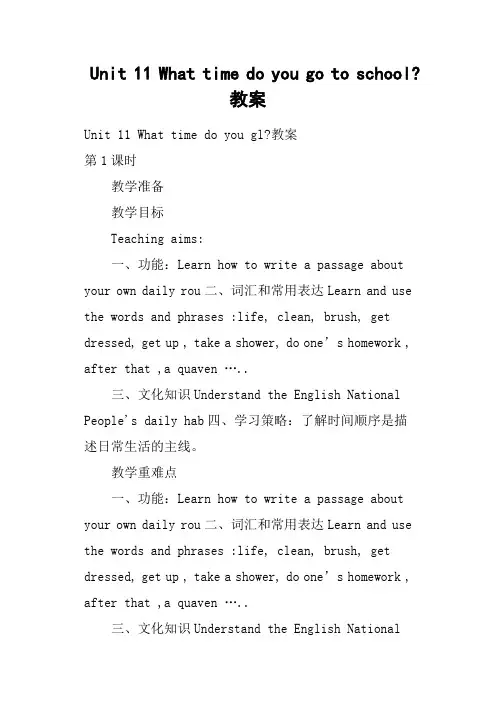
Unit 11 What time do you go to school?教案Unit 11 What time do you gl?教案第1课时教学准备教学目标Teaching aims:一、功能:Learn how to write a passage about your own daily rou二、词汇和常用表达Learn and use the words and phrases :life, clean, brush, get dressed, get up , take a shower, do one’s homework , after that ,a quaven …..三、文化知识Understand the English National People's daily hab四、学习策略:了解时间顺序是描述日常生活的主线。
教学重难点一、功能:Learn how to write a passage about your own daily rou二、词汇和常用表达Learn and use the words and phrases :life, clean, brush, get dressed, get up , take a shower, do one’s homework , after that ,a quave n …..三、文化知识Understand the English NationalPeople's daily hab教学过程Before-writing:I. Teaching AT:Today we are going to talk about daily activities and learn how to write about daily routine. ( 设计意图:展示目标,让学生有目的学习提高学习的自主性和主动性。
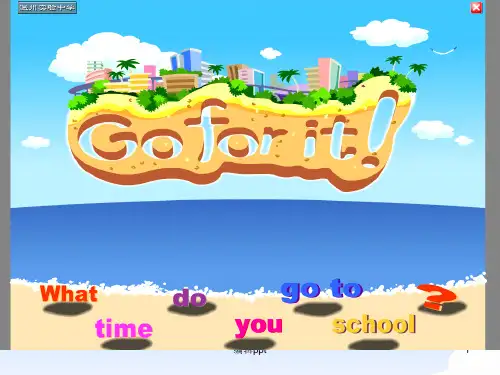
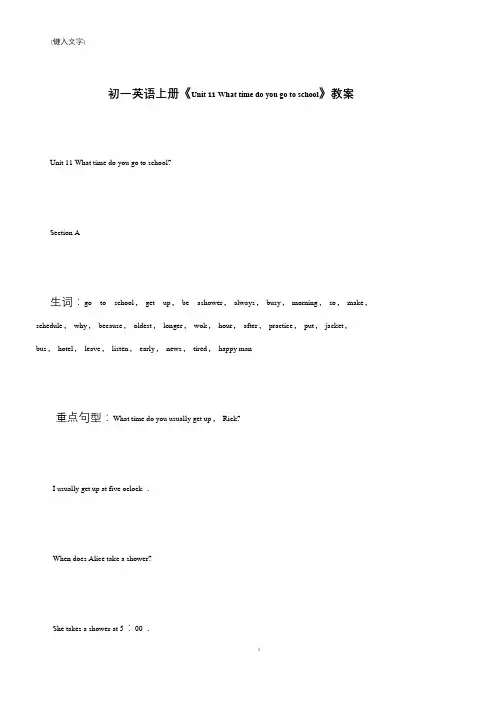
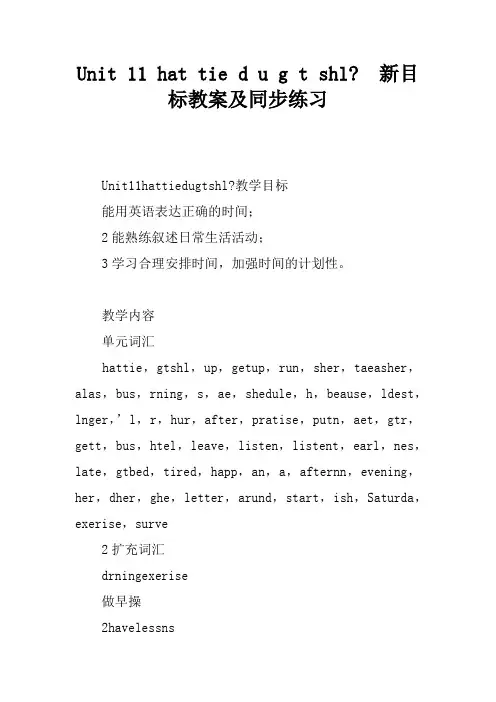
Unit 11 hat tie d u g t shl? 新目标教案及同步练习Unit11hattiedugtshl?教学目标能用英语表达正确的时间;2能熟练叙述日常生活活动;3学习合理安排时间,加强时间的计划性。
教学内容单元词汇hattie,gtshl,up,getup,run,sher,taeasher,alas,bus,rning,s,ae,shedule,h,beause,ldest,lnger,’l,r,hur,after,pratise,putn,aet,gtr,gett,bus,htel,leave,listen,listent,earl,nes,late,gtbed,tired,happ,an,a,afternn,evening,her,dher,ghe,letter,arund,start,ish,Saturda,exerise,surve2扩充词汇drningexerise做早操2havelessns上3plaftball踢足球4dseleaning做清洁plathepian弹钢琴6athTV看电视7listenttheradi听收音机8readnespapers看报纸9lginline上网/surfinline,surftheinternet 0supper做晚饭1ritediar写日记2dseashing洗东西3plahess下棋4plaputergaes玩电子游戏3句型—hattieduusuallgetup? —Igetupatsix’l你经常什么时候起床?我六点起床。
—hendesAliataeasher? —Shetaesasheratfive’l艾利卡什么时候洗澡?她五点洗澡。
—hattieisit?—It’seleven’l几点了?十一点。
重点讲解关于时间(tie)a时间的表达法:(1)直读式,即直接读出时间数字eg7:0sevenfive8:16eightsixteen9:30ninethirt0:47tenfrt-seven(2)过、差式,即几点差几分,几点过几分。
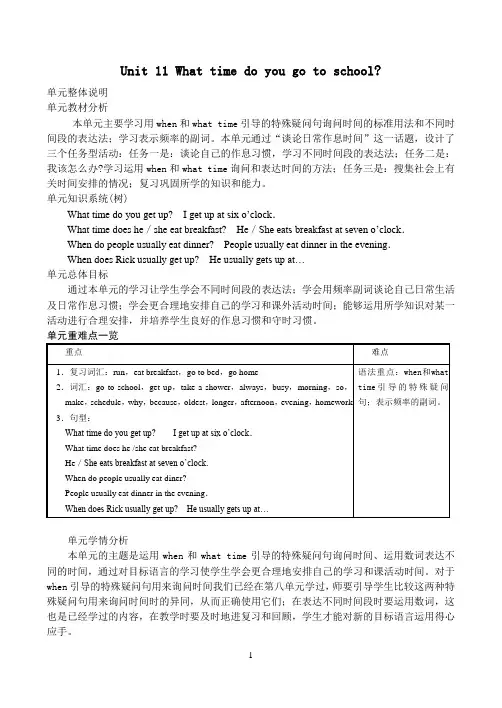
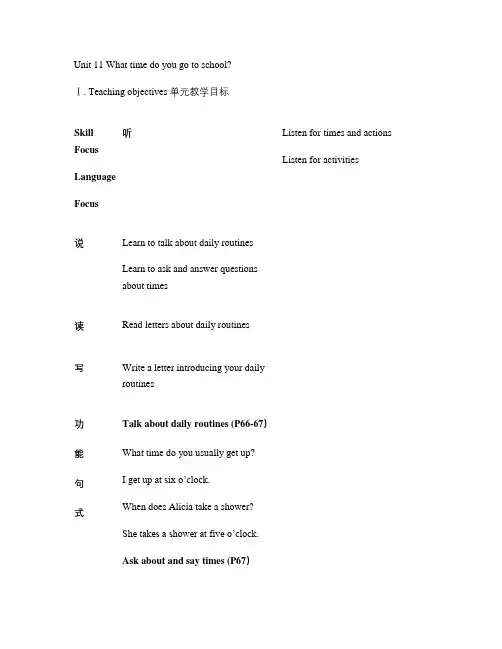
Unit 11 What time do you go to school? Ⅰ. Teaching objectives 单元教学目标Skill FocusLanguageFocus 听Listen for times and actionsListen for activities说Learn to talk about daily routinesLearn to ask and answer questionsabout times读Read letters about daily routines写Write a letter introducing your daily routines功能句式Talk about daily routines (P66-67)What time do you usually get up?I get up at six o’clock.When does Alicia take a shower? She takes a shower at five o’clock. Ask about and say times (P67)What time is it?It’s eleven o’clock.Ask for daily actions (P66)What do you do in the evening? When do people usually eat dinner?词汇1. 重点词汇run, get, up, shower, take, always, busy, morning, so, make, why, because,o’clock, work, hour, af ter, put, bus, leave, listen, early, news, tired, happy, man, am, afternoon, evening, homework, letter, around, start, wish, Saturday, late2. 认读词汇schedule, oldest, longer, practice, jacket, hotel, exercise, survey, Jerry, Alicia, Selina, Jennifer3. 短语go to school, get up, take a shower, put on, go to work, get to, listen to, go to bed, do homework, go home, in the morning, in the afternoon, in the evening语法When questionsWhat time is it?(formulaic)Adverbs of frequency话题Daily routines and timesⅡ. Teaching materials analyzing and rearranging 教材分析与重组1. 教材分析本单元以Daily routinesand times为话题,共设计了三个部分的内容。
Unit 11 What time do you go to school?LESSON 1I. Language Goals:Talk about routines.Ask about times.-New Language:What time do you get up? OR When do you usually get up?I get up at five o’clock. OR I usually get up at five o’clock.When does she take a shower?She takes a shower at five o’ clock.What time is it?It’s ten o’ clock.II. Teaching Aid:Teaching clock with moveable handsIII. Vocabulary Words:Routines, run, eat breakfast, go to school, do homework, go to bed, shower, o’clock, morning, get up, usually, pen pal, arrive, around, pretty, lunch, quarter, noon, break, finish, half, evening, hourIV. Teaching Steps:1.Greetings.2.Read the short description below (about routines). Tellstudents that this is what Nancy’s pen pal does everyday. Listencarefully.*I usually get up at a quarter past seven-that’s seven fifteen in the morning. I have breakfast at eight o’ clock andthen take the bus to work at half past eight. I usually arriveat work at a quarter to nine. My morning is usually pretty busyand I like taking a lunch at noon. In the afternoon, I usuallyhave another break at three fifteen. I usually finish work ata quarter to five and arrive home around six in the evening.At night, I usually go to bed at eleven o’ clock.3. Read the vocabulary words on the board.4. Read again and ask students to repeat every word after you.5.Give the meaning of every word using the description above.Don’t forget to use some gestures to make every meaning clear.6. Ask the class to read the words again. Correct every mispronounced word.7. Have students do exercise 1a. Check the answers afterwards. 教学一得:在新课程当中,虽然教师不再是课堂的主体,但教师的作用仍然是举足轻重的,一节课的效果如何,关键在于教师的引导和带动,所以教师的情绪回左右课堂。
这一点,每个教师都要注意。
LESSON 21.Say, look at the rules for telling time in English.a. In English we use “past”to say times after the hour until half past,or 30 minutes past the hour. Example: 9:30 – It’s half past nine.b. In English we use o’ clock only at the full hour. Example: 2:00 – It’s two o’ clock.c. We can also say the number in groups of two. Example: 7:25 – It’s seven twenty – five.d. When speaking about the different times of the day we often use: in the morning, in the afternoon, in the evening.e. In English we use “at night” not “in the night.2.Ask students to do activity 1b. Remind them to listen carefully.3.Ask students to practice the dialogue in pairs.What time do you usually get up, Rick?I usually get up at five o’ clock.4.Let the children listen to the conversation (2a) and ask them to dothe written exercises (2a and 2b)5.Discuss grammar focus.Go over the rules for telling time. Try to extendthe grammar focus by giving more examples. Below is just a simple example. Take note how questions are answered. Look at the verbs used.What time do you get up? I get up at six o’ clock.What time does he eat breakfast? He eats breakfast at seven o’ clock.What time does she go to school? She goes to school at eight o’clock.6.Ask students to read the grammar focus repeatedly.教学一得:教师应为学生创设宽松,和谐,民主的学习气氛,设计多种合作方式或活动内容,多思考导入的途径和技巧。
怎样让每个孩子都说话,每个任务都有话说。
LESSON 31.ORAL PRACTICE: Go over the shower schedule (2b). This time teachstudents on how to ask and answer questions correctly. Then let students do it in pairs..2.Introduce the passage (3a). Read it aloud to the students then ask themto read it after you.3.Have the students answer the written activity (3a).4.MORE ORAL PRACTICE! Talk about parts of the day (morning, afternoonand evening).5.Ask the students about their daily routines or every day activitieslike: get up, eat breakfast, go to school and so on and so forth.6.Take students to the pictures under Section B 1a. Let them answer.7.Point the conversation in the picture 1b. Ask a partner questions aboutwhen people do these things. (PAIRWORK)Example: When do people usually eat breakfast? People usually eat breakfast in the morning.8.Now call a student and ask him/her to read the conversation in thepicture (2b). Ask the students then to work in pairs. Direct pairs of students to ask and answer one or two questions as the class listens.9.Proceed to activity 3a. Call attention to the letter from Jennifer toSelina. Read it aloud then ask a student to read it again. Encourage students to ask questions about the contents of the letter and answer every question.10.Have the students read the letter again and ask them to answer thewritten activities (3a and 3b). Then check the answers afterwards. 教学一得:学生已经从死背语法知识,机械模仿句型为主的学习方式过渡到“做中学”的活学活用阶段。